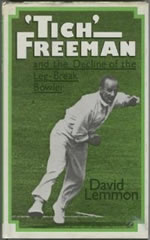Tich Freeman and the Decline of the Leg-Break Bowler
David Taylor |Published: 1982
Pages: 144
Author: Lemmon, David
Publisher: George Allen & Unwin
Rating: 3 stars

The writer David Lemmon, who died in 1998, specialised somewhat prolifically in English county cricket – a sort of Stephen Chalke without the nostalgia. As his Wisden obituary noted, sometimes the quantity of his output overwhelmed the quality, and some of his titles, like this one, are on the slim side. As an enthusiast of all things concerning Essex cricket, one of those which must have given him the greatest pleasure is Summer of Success, the story of the county’s first trophy winning season of 1979. That is a review for another time, but for this work he ventured south to tell the story of Alfred Percy ‘Tich’ Freeman of Kent and England.
Everything about Freeman’s career is extraordinary. Born in 1888, he had only just established himself in the Kent side when the Great War arrived. After missing four seasons he was 31 when county cricket resumed. Yet he went on to take more wickets than anyone but Wilfred Rhodes. He is the only bowler ever to take 300 wickets in a season – the start of a phenomenal run that brought him 1,673 wickets in six seasons starting when he was 40 years of age. He took all ten wickets in an innings three times, in consecutive seasons again all after turning 40. His career seems completely anachronistic nowadays, and he achieved figures that could not be approached today. And he did it bowling leg-spin, undoubtedly the hardest bowling style to master.
The book begins with a reminder of how much the art was disappearing in English cricket by the early 1980s. Just two regular practitioners played in 1981, Intikhab Alam and Robin Hobbs; both retired at the end of the season. The last chapter is a brief resume of English Test leg-spinners after Freeman’s time, such as Doug Wright and Eric Hollies. And that pretty much accounts for the second part of the title. Lemmon offers little by way of explanations or solutions for the decline of this type of bowling (the book was written pre-Warne and Kumble, of course, although Abdul Qadir was about in 1983; however this is concerned primarily with English cricket). The bulk of the book is taken up with Freeman’s story.
‘Tich’ was born into a cricket family – his brother John and cousin CAG ‘Jack’ Russell both played for Essex, and Jack was good enough to score 71 hundreds and play ten times for England. Freeman had trials for Essex but was unable to secure a contract, and joined Kent in 1912. His debut was delayed in part because the county already had one world-class and one very good spinner in Colin Blythe and DW Carr, as well as all-rounder Frank Woolley. But after the war Blythe was dead, Carr had retired and Woolley was starting to concentrate on his batting, which left the way clear for the little man from Lewisham. He started quietly by his later monumental standards, with 60 wickets in 1919 and 102 the following year. And 163 in 1921 was not enough to secure him a Test place, although England used 30 players that season – Lemmon makes the point that then, as now, spinners who could bat well were preferred.
Of course England played much less in those days – there were no home Tests in 1923 for instance – but Freeman’s treatment by the selectors, 12 matches in which he took 66 wickets, seems baffling in retrospect. Lemmon goes some way to explaining it while giving the impression that he thought ‘Tich’ was hard done by. With eight pages of photographs and a good statistical section this title is worth acquiring despite its slim size.






Leave a comment